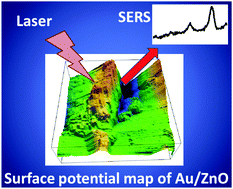Surface potential and morphology mapping to investigate analyte adsorption effects on surface enhanced Raman scattering (SERS)†
Abstract
We demonstrate the power of Kelvin probe force microscopy (KPFM) in enabling a comprehensive study of enhancement mechanisms of surface enhanced Raman scattering (SERS) through the correlation of surface electrical and topographical effects. Local electric fields generated on Au/ZnO nanohybrid films impact analyte adsorption, while roughness is linked to hotspot generation. Optimizing the interplay between these two effects yields SERS enhancement factors (EFs) of 106, enabling ppb detection of polycyclic aromatic hydrocarbons (PAHs) in water.



 Please wait while we load your content...
Please wait while we load your content...